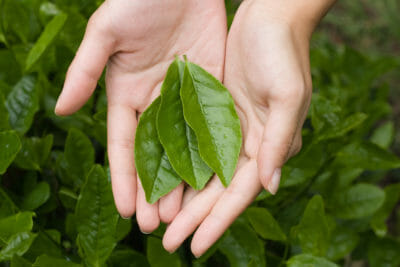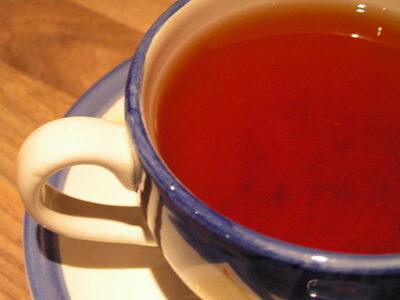|
Listen To The Article
|

You can make a tea garden in your own backyard simply by growing tea plants and harvesting their leaves.
We have been hearing about the health benefits of tea for years now. Whether black, green, or white, tea is a powerhouse of nutrients, antioxidants, and other compounds. Also, it tastes delicious and provides a little boost of caffeine and the comfort that only a warm beverage can bring. Numerous medical studies have found that tea contains compounds that exhibit anti-cancer properties. This does not mean that drinking tea will prevent anyone from getting cancer, but it certainly can’t hurt. Other potential benefits include supporting and maintaining weight loss, reducing the risk of heart disease, preventing diabetes, and lowering cholesterol.
Before modern science could tell us how wonderful tea is, people already seemed to know. Humans have been cultivating tea plants and drinking tea for so long that no one can really say when and where it first appeared. Most likely the plant was first grown by people in the region of southwest China, northeast India, Burma, and Tibet. What we know for sure is that tea as a beverage has been around for at least 5,000 years.
With the popularity of tea these days, it is not difficult to find it at any grocery store, nearly anywhere in the world. You can buy inexpensive black teas or pricey, organic loose teas and everything in between. But, what about making your own? It is definitely possible to grow tea plants, harvest the leaves, and then create and brew several varieties of tea. In essence, you can easily create your own tea garden right in your backyard.
The Tea Plant
All genuine tea comes from just one species of plant: Camellia sinensis. There are four different types of tea that can be made from the leaves of this plant, and those are black tea, green tea, white tea, and Oolong tea. Any other “type” of tea is not really tea and comes from a different plant. There are two subspecies of the tea tree, which are Camellia sinensis sinensis and Camellia sinensis assamica. Sinensis sinensis has smaller leaves and grows in the cool, mountainous environment of places like China and Japan. The assamica variety is a taller plant and thrives in moist, low elevation, tropical locations like India and southwest China.
The tea plant is a shrub that grows to about one to two meters tall. In fall, it develops small, white flowers that smell wonderful. The leaves are dark green in color and have a smooth, shiny texture. The fruits that follow the flowers are hard and small and the seeds are about one quarter of an inch in diameter. The assamica tea plant can grow up to 65 feet tall and produces larger leaves.
Growing Your Very Own Tea Garden
For growing your own tea garden at home, you will probably want to avoid the assamica plant and stick with using sinensis sinensis. The assamica is very large and requires a tropical environment. Sinensis is hardy through zone eight in the U.S. However, if you live in a colder zone, you can still grow a tea plant in a greenhouse or in a container that you move indoors in the winter.
You can grow your tea plant from seed or from a cutting taken from an existing plant. You may also be able to find a plant at a local nursery. If you are growing from seed, germination will take about four weeks. Cover the seeds lightly with soil and keep it damp and warm. When starting from seeds, be prepared to wait a few years to make tea. It takes at least three years to get a plant that will produce enough leaves for you to make a harvest. If you are using a cutting, nurture it indoors for a year before transplanting outdoors.
Use soil that is slightly acidic. You can buy soil that is designated for rhododendrons to keep a tea plant happy. To maintain the right acidity for your tea garden, water with soft water only. If you are growing your plant in a container, give it a shot of fertilizer a couple of times in the summer, but otherwise it will be happy. Your plant will be happy in full sun, but it also tolerates shade. It will tolerate a drought better than many of your vegetables. In other words, growing tea is not very difficult!
If your location is warm enough, put your plant outside in the tea garden in a spot where it will get sun and maybe a little bit of shade. Put it up against a wall or tree to protect it from strong winds. If you are planting more than one tea bush, put them at least three feet apart from each other. Prune them back about every four years to keep the plants productive and to keep them from getting too big and too tall. If you take care of your tea plant, you will have tea for the next 50 to 100 years.
Harvesting Tea
Your tea plant will go dormant in the winter. When new shoots appear in the spring, this is called a flush. Pick the new growth, the two smallest leaves, and the bud for your tea. The warmer your climate is, the more flushes you will get per year, which makes a greenhouse a good idea for growing a tea garden in colder areas. Once you have plucked your new growth, then you have tea. The harvest is that simple. What you do with the harvest determines whether you will make black, green, white, or Oolong tea.
Making Tea
The leaves that you harvest from your tea garden are themselves tea. To get different flavors out of those leaves, you must prepare them differently. The directions for making green and white tea are the same. For white, however, use only the buds and not the leaves.
- Green tea. Spread out your harvested leaves and buds and leave them in a shady spot for a few hours. Steam them on the stove top for about a minute or roast them in a hot, dry skillet for a couple of minutes for a different flavor. Dry the leaves on a baking sheet in the oven at 250 degrees for about 20 minutes. You can store the dried leaves in an airtight container or brew right away.
- Oolong tea. To make Oolong tea, let the leaves and buds wilt in the sun for a half-hour to an hour. After that, leave them in the shade or inside for up to ten hours, with regular mixing. You may dry them in the oven at 250 degrees for 20 minutes. You can also treat Oolong tea in the traditional manner, which is to skip this step. Instead, roll the leaves into thin strips or small balls. They will unfurl as you brew them, but they won’t store as long as if you dry the leaves in the oven.
- Black tea. After you pick the leaves and buds, roll them between your fingers and hands until they turn a darker color. Spread the leaves out on a flat surface in a cool place and leave them to dry for two to three days. Then, dry and store the leaves as you would for green or Oolong tea.
Herbal Teas

Herbal tea is any beverage that is brewed from a plant other than Camellia sinensis.
An herbal tea is any beverage that is brewed from a plant other than Camellia sinensis. There is a huge amount of variety in herbal teas. In addition, there are many, many plants that you can grow, harvest, dry, and brew to make a tasty tea. Some of the more common plants that you can use for tea are:
- Peppermint [1]. Peppermint tea is made from the plant leaves and is very refreshing. It also settles the stomach. The plant is very easy to grow, but use a container or it will take over your garden.
- Lavender. This fragrant plant makes a tasty and soothing tea that can reduce tension and relieve headaches. Use the buds to make tea.
- Lemon verbena. Another easy herb to grow, the leaves of lemon verbena make a zingy, lemony, and refreshing drink. Grow it in a container and bring it inside for the winter.
- Rose hips. They are not exactly an herb, but the seed cases on your rose bushes make a tart and delicious tea. They are also very high in vitamin C.
- Bergamot. Bergamot has a slightly citrus flavor. You can use the flowers and leaves as tea or add it to your black tea to make a homemade Earl Grey blend.
- Chamomile [2]. Chamomile plants are easy to grow and produce lovely, daisy-like flowers. When dried, these flowers make a tea that is calming and often used to induce sleep.
- Jasmine. The flowers of the jasmine plant have an intoxicating smell and can add a fragrant flavor to your tea, especially green and white tea. This is a warm weather plant, so if you have cold winters, grow it in a container and bring it indoors. It also requires a trellis or other type of structure on which to climb.
You may also be interested in reading an additional Off The Grid News article: Using Wild Plants For Teas: Brewing Your Own Backyard Herbal Medicines [3]
Do you have any other suggestions on how to start a backyard tea garden? Let us know in the comments below.
©2018 Off the Grid News
